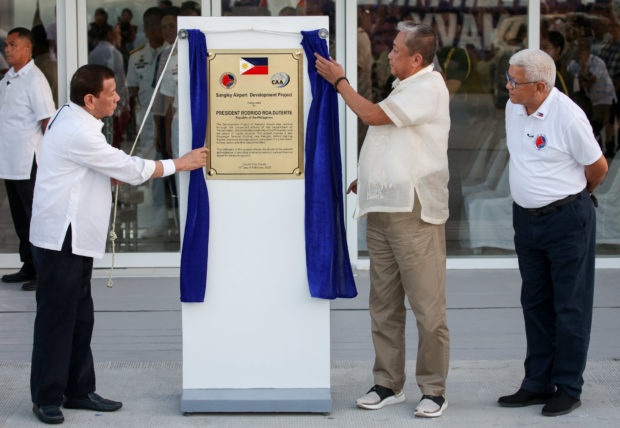
AIRPORT UPGRADE President Duterte and Transportation Secretary Arthur Tugade inaugurate the Sangley Airport Development Project in Cavite City upon completion of the former Air Force base’s rehabilitation. —LYN RILLON
MANILA, Philippines — Philippines President Rodrigo Duterte was given a preview of a potential solution to the congested Ninoy Aquino International Airport (Naia) in Manila as the Cavite provincial government unveiled plans for Sangley Point International Airport (SPIA) on Saturday.
Duterte inaugurated for commercial use the existing Sangley airport, a former Philippine Air Force base, which was recently upgraded by the Department of Transportation (DOTr) at a cost of P486 million to accommodate small aircraft.
The upgrade was completed last November, the deadline set by the President, who got angry after a lightning storm grounded flights at Naia in June 2019.
Duterte on Saturday appeared impressed with the improved airport, which has a 2,400-meter runway, a terminal for 160 passengers and an apron for up to five turboprop planes.
“I will take my last flight as President to Davao. I will use this airport,”he said. The President’s term ends in 2022.
World-class gateway
The Sangley airport will transform anew in a few years should the Cavite government proceed with a P550-billion plan to develop a world-class gateway competitive to such airports as Singapore’s Changi and South Korea’s Incheon.
It is expected to compete with San Miguel Corp.’s P735-billion New Manila International Airport in Bulacan province, northwest of Manila, which is still under government review.
“This project is meant to change the country. It will change everything,”Cavite Gov. Jonvic Remulla said on the sidelines of the inauguration.
The event was also attended by Cabinet officials and administration allies, including Sen. Christopher “Bong”Go, Transportation Secretary Arthur Tugade, Finance Secretary Carlos Dominguez III and Defense Secretary Delfin Lorenzana.
The airport will feature multiple parallel runways and terminals that can handle up to 130 million passengers per year””enough to handle air traffic demand until 2050.
The local government’s master plan includes a 4.6-kilometer Sangley-Kawit Connector road that will cut road travel time between SPIA and Makati City from 1.5 hours to about 30 minutes.
There are also long-term plans for a railway link to the capital.
At present, the fastest access to SPIA is by water ferry, which takes about 20 minutes from the Cultural Center of the Philippines’ Bay Terminal.
Given its scale, SPIA will also require the reclamation of about 1,500 hectares of land on Manila Bay.
Duterte earlier branded huge reclamation proposals on Manila Bay as environmental hazards. But he indicated on Saturday the Philippine Reclamation Authority, which is under the Office of the President, may allow SPIA to proceed since it is a government-led project.
On Friday, the Cavite government formally selected state-run China Communications Construction Co. Ltd. (CCCC) and MacroAsia Corp., an aviation services company led by Philippine Airlines owner Lucio Tan, as its joint venture partner.
First phase
CCCC-MacroAsia will build the first phase of SPIA covering one runway and a passenger capacity of 25 million annually that could be finished as early as 2022.
The award was made despite questions raised on the joint venture selection process that favored a Chinese partner and the role CCCC played in building militarized islands in contested waters in the South China Sea.
National security concerns were also raised on China securing a strategic air base close to Metro Manila, located about 35 km away. The Cavite government said it was looking for solutions to deal with those concerns.